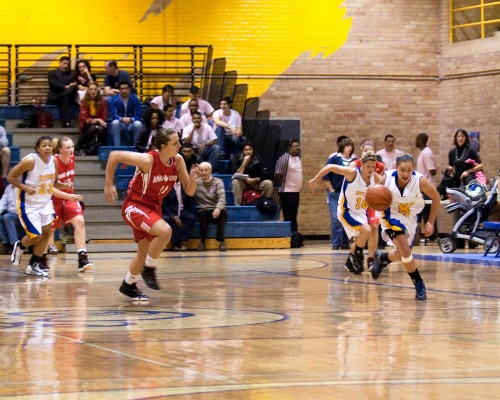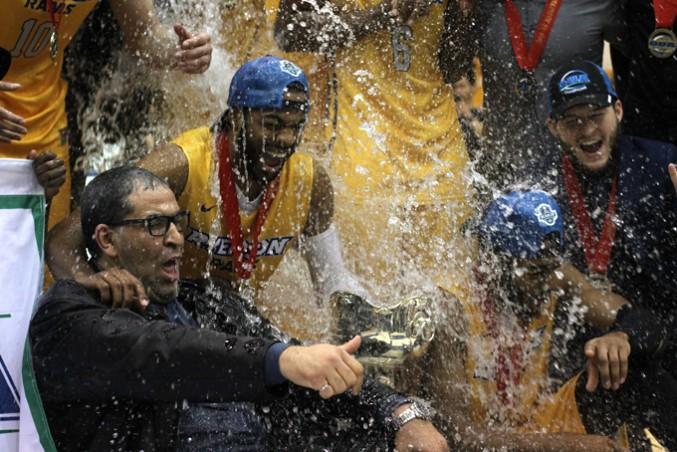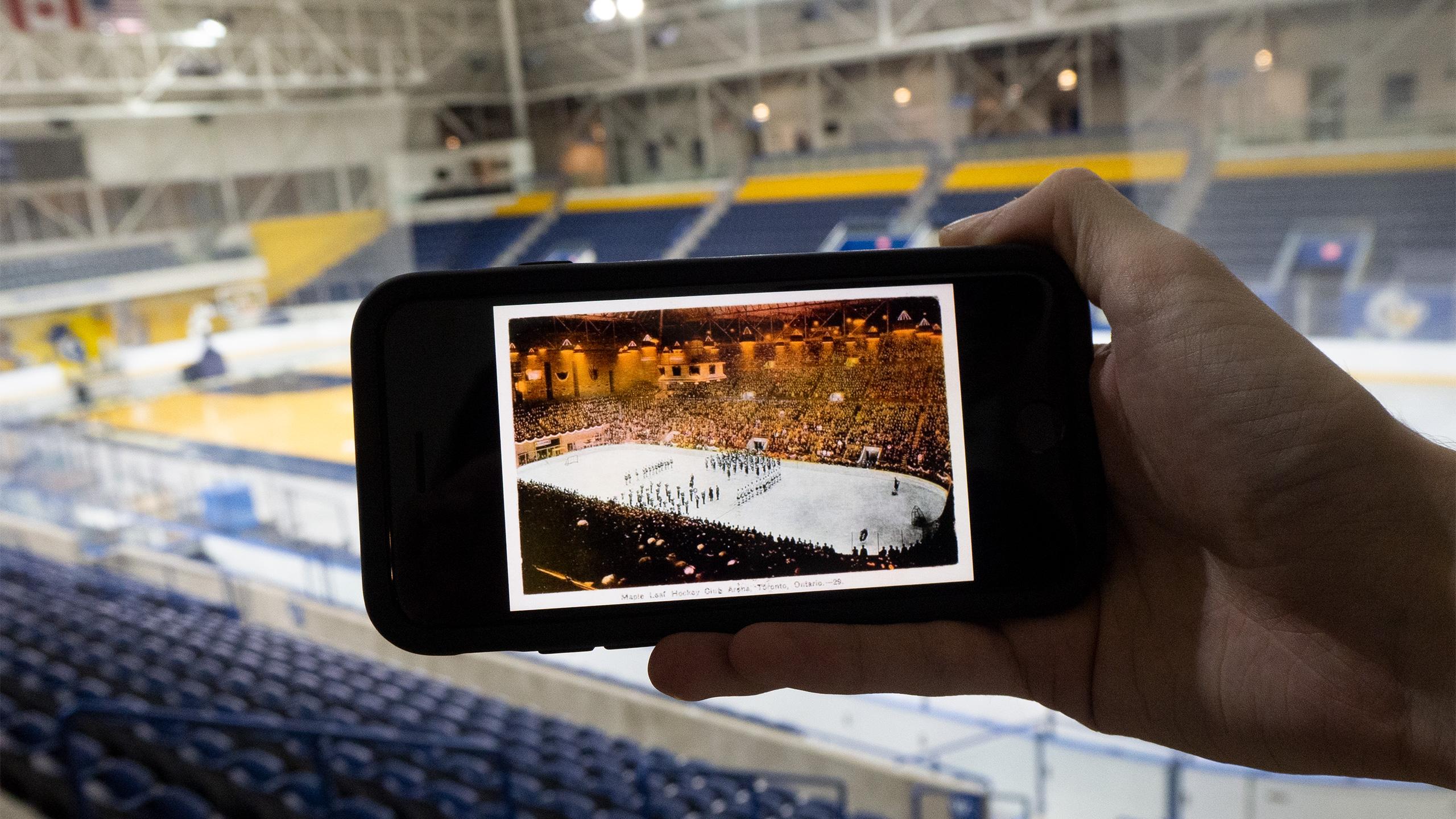By Will Baldwin
On the first weekend of September 2012, the stands for the men’s hockey exhibition opener were packed. The energy at the game was something Ryerson had never really seen before. For the first time in decades, there was a buzz around Ryerson athletics.
The Ryerson Rams had finally found a real home: the Mattamy Athletic Centre (MAC), previously known as Maple Leaf Gardens.
All the administration wanted was a place that Ryerson students and athletes could feel proud of. What they got was a level of success that few considered possible for the department.
Not long ago, Ryerson’s athletic department was something of a punch line in Ontario’s university sports scene. The school was the only one without an Ontario University Athletics (OUA) conference championship, let alone a national championship.
In a city with two other university athletic departments —the York University Lions and the University of Toronto Varsity Blues— the Rams were a distant third place.
The basketball and volleyball teams played in the Kerr Hall Gymnasium and the hockey teams played all the way out at George Bell Arena, a full hour away from campus via the Toronto Transit Commission (TTC) in the Junction neighbourhood.
In 2008, then-Ryerson president Sheldon Levy tasked Dr. Ivan Joseph with fixing the school’s virtually non-existent athletic reputation.
Dr. Joseph came from Graceland University in Iowa. He led the school’s men’s soccer program to a National Association of Intercollegiate Athletics championship among other achievements in his time there. This gave him a winning pedigree, something few others—if any—associated with Ryerson athletics had.
“It was too beautiful to be covered”
Part of Dr. Joseph’s recruiting process coming in was Levy’s promise of some type of new facility as the university knew its facilities were part of the problem.
“The public’s perception of your athletics teams influences their interpretation and their perception of your academic reputation,” Dr. Joseph said. “That made the university pay attention to the value athletics played in helping to elevate the academic reputation of this university.”
When Dr. Joseph came to the school, nothing was guaranteed. Although it was agreed a new facility was needed and on its way— where and what it would look like was completely up in the air.
Ideas like upgrading Kerr Hall, re-doing the Ryerson Athletic Centre, or even buying another building were tossed around but nothing was sticking. Luckily for the university, just a block off-campus was a national historic site with a vacancy.

oronto’s Maple Leaf Gardens was built in 1931 to replace the team’s old home, the Arena Gardens. From its inception, the Maple Leaf Gardens became one of the most iconic buildings in the country, coming to be known as a “cathedral of hockey.” The Gardens played host to everything from the Maple Leafs, to The Beatles, to a Muhammad Ali fight, to countless other concerts and political rallies that helped incentivize the Canadian government to make it a national historic site in 2006.
By the late 90s, the arena had run its course as a realistic home for the Maple Leafs, so the team built a new arena. With the Maple Leafs moving out in 1999 to the Air Canada Centre (ACC, now Scotiabank Arena) and the Toronto Rock (Toronto’s professional lacrosse team) joining them in 2000, it left the arena without a major tenant.
In 2004, Loblaws and Maple Leaf Sports and Entertainment (MLSE) came to an agreement on the purchase of the building. Financial issues around renovating the building made it sit dormant for years after the deal. Part of this was due to a condition from MLSE that the arena couldn’t host events that competed with the ACC.
Left with a massive bill for renovation, Loblaws was in need of a partner to make it work. As luck would have it, Ryerson was in need of a new home for its athletic facilities. It was a partnership destined to happen, the university just had to hold up its end of the bargain.
To make Maple Leaf Gardens a possibility for Ryerson, Dr. Joseph needed to get a student referendum passed for the funding. In 2004, a similar one was attempted for a facility upgrade but 60 per cent of the students that voted said no.
Five years later though, 74 per cent of voters approved the extra $126 fee hike to student fees to make a new facility possible. When the referendum was won, Galen Weston of Loblaws contacted Levy, forming a financial partnership that would take the dream to a reality, according to Dr. Joseph.
In 2009, it was announced a deal had been reached and an approximately $60 million dollar renovation would ensue. The deal included $20 million from Stephen Harper’s federal government and $20 million from the students.
“That will be a memory that will last forever”
After years of inactivity and three years after the deal in 2012, Canada’s cathedral of hockey had a new name and purpose as the home of the Ryerson Rams.
Throughout construction, the plan for how to execute Ryerson’s new athletic home changed a couple of times. Though this made construction more stressful, Dr. Joseph said he’s proud of the process. “There’s very few projects where you start building one way and end up finishing in a completely different, better way.”
One of the early plans called for the iconic roof and scaffolding to be covered. As Dr. Joseph says, however, “It was too beautiful to be covered.”
As part of the referendum, Dr. Joseph talked to 2,100 students to see what they wanted in the new facility. From that survey of student opinion, Dr. Joseph went to the construction team with a plan of action for Ryerson’s new home.
Part of the challenge was fitting a rink, court and weight room in a building that used to just be an arena. One of the things they did to maximize the space according to Dr. Joseph was to move the rink 10 stories up into the rafters of the old design.
Three years after Ryerson agreed to move in and 13 years after the final Maple Leafs’ game, the building was almost ready. Before opening officially to the public once it was completed in the summer of 2012, the facility received a legendary approval from a Hockey Hall of Famer that cemented it was ready for its return.
Dr. Joseph got to walk the building with Toronto Maple Leafs legend, Red Kelly. Kelly knew the old Garden well, having played 470 games for the Maple Leafs over the course of eight NHL seasons. His final season was 1966-67—an important year for the franchise and the last time they won the Stanley Cup.
As Kelly walked his former home, he couldn’t help but marvel at what it had become. When he got to the third floor that overlooks the arena, Kelly was full of emotion according to Dr. Joseph.
“Oh my God, this feels like home, you captured it. It’s perfect,” Dr. Joseph remembers him saying. If the athletic department needed any confirmation that they had done a good job, this was the highest possible praise.
“When you get somebody who lived in that building, who called it home, who looked at is a shrine, that is the greatest compliment we could’ve got,” Dr. Joseph said.
With the seal of approval of a man whose jersey used to hang in the building’s rafters, Maple Leaf Gardens was set to reopen, with a new name of course.
Dr. Joseph counts many moments as Ryerson’s athletic director as unforgettable, but he said very few match the first weekend the MAC opened to its students in September 2012.
He remembers being full of pride at what the school had created in such a short time. As he stood on the concourse and viewed the first of many great nights in Rams history at the MAC, he couldn’t help but smile.
The stands were packed. Students were getting the communal university experience he dreamed of for them. Above it all was the famous roof of one of sports’ most iconic buildings. It was a perfect marriage of old and new and somehow, it was now the home of the Ryerson Rams.
Now that the teams had a facility to be proud of, Dr. Joseph could tackle the next foundational element under his control: coaching. Dr. Joseph already had respected names like men’s basketball coach Roy Rana and women’s volleyball coach Dustin Reid on staff and with the 2011 and 2012 additions of Lisa Haley and Carly Clarke to coach women’s hockey and basketball respectively, Ryerson had one of the most impressive coaching groups in the conference by the time the MAC opened its doors.
Clarke’s first year leading the women’s basketball program came in that inaugural 2012 season. Early on, she observed the differences between Ryerson and the University of Prince Edward Island and Dalhousie University—two programs she previously coached at in terms of history and prestige. However, she instantly noticed the devotion of her new university to athletic excellence.
“The mission of the department was very, very clear and that was around creating exceptional student experiences,” Clarke said.
Clarke found the school’s commitment to “being innovative and forward-thinking,” as a factor that helped make up ground in the competitive conference of the OUA. She thinks that it can be seen as a separating factor for the school saying it’s “what made it special and what makes it currently special.”
In 2015, Dr. Joseph and the department put that mission on paper when they unveiled “Higher Expectations – 2015-2020 Strategic Plan.” The three main points of the plan were to foster exceptional student experiences, champion vibrant community engagement and build capacity and operational excellence.
“The mission of the department was very, very clear and that was around creating exceptional student experiences”
Just a year later, the department celebrated its first two conference championships. In the span of about 15 minutes, Ryerson went from having no conference titles to having two as the men’s and women’s basketball programs both captured the inaugural titles on the evening of March 13, 2016.
“That will be a memory that will last forever,” said Dr. Joseph on the historic night.
Two years later, the women’s volleyball team captured the school’s first national championship, a moment that made Dr. Joseph’s “heart burst with joy.”
That championship would be Dr. Joseph’s last at Ryerson as he would move on to Dalhousie to become the school’s vice provost, student affairs the next school year. Ryerson replaced Dr. Joseph with Louise Cowin who came to the school with equally high expectations for the department.
Cowin came to Toronto after more than 25 years of experience in post-secondary education. Her most recent job before Ryerson was as the vice-president, students at the University of British Columbia. According to Ryerson’s athletics website, Cowin spent two years as the acting director of the Athletics and Recreation Department where “the varsity program extended and expanded its winning trajectory.”
Now in charge of Ryerson’s athletics since August 2019, Cowin recognizes the impact of the MAC in recruiting and day-to-day competition for the school, describing the facility as having a “wow factor.”
Brian Finniss is the director, sport at Ryerson. Finniss agreed with Cowin on the recruiting advantages of the building, describing it, “as a very impressive facility for some of our student-athletes when they first come and visit.”
While the advantage in recruiting is important, Finniss pointed to a structural asset of the MAC that provides athletics day-to-day with added advantages that have been integral to their success since moving in.
“It is nice to have a lot of our resources in one central location,” said Finniss. “We have our athletic offices, coaches’ offices, athletic therapy clinic, strength and conditioning space, study hall, etc. all in one location (which is often not the case at other universities), so it is easier for the student-athletes.”
“[It gave] us a place to call home. Where everybody felt like they mattered and belonged”
Clarke also pointed to the centrality of the facility as being “pretty special,” and that it helped to build a “great coaching culture to be a part of.”
Though Cowin is convinced about the advantages of the building, she knows success will also come thanks to the people in the building.
“What will drive further competitive success for the Rams is not just facility-related, it also includes Ryerson having the best coaches who are therefore able to recruit the best student-athletes,” Cowin said. “Its facilities plus excellent coaches plus financial assistance plus other student-athlete supports.”

hile the MAC itself didn’t necessarily have a hand in hiring coaches or winning championships, it was a substantive force in changing a culture that slightly over a decade ago, hardly existed.
Just five years ago Ryerson had no championships to its name. Now, three different varsity sports teams have brought home conference titles and one has a national title banner that now hangs in the MAC.
Championship success was certainly part of the vision for Dr. Joseph but to only look at that part of the story would be to ignore what matters most to him to this day. His greatest accomplishment at Ryerson in his mind is, “how much we contributed to the campus spirit and pride.”
As for the building that now defines a large part of his legacy at Ryerson, he’s proud of what it has done for the university’s reputation.
“I think MAC did exactly what it was supposed to,” said Dr. Joseph. “[It gave] us a place to call home. Where everybody felt like they mattered and belonged.”
Maple Leaf Gardens and the Mattamy Athletic Centre by the numbers
| 0 | 45 | $60 Million | 1931 | 3 |
conference titles won by Ryerson Athletics prior to moving into the MAC | minutes via transit from campus to George Bell Arena, one of the main reasons hockey attendance at home games struggled | dollars budgeted for renovation of the MAC, financed by Ryerson, the Canadian Federal Government and Loblaws. | was the year on the time capsule found by construction workers during renovation in 2011. The capsule was from the opening of the original building in 1931. | concerts played by The Beatles at Maple Leaf Gardens. The arena was used for far more than just sports, playing a regular host to concerts and other events large events. |











Leave a Reply